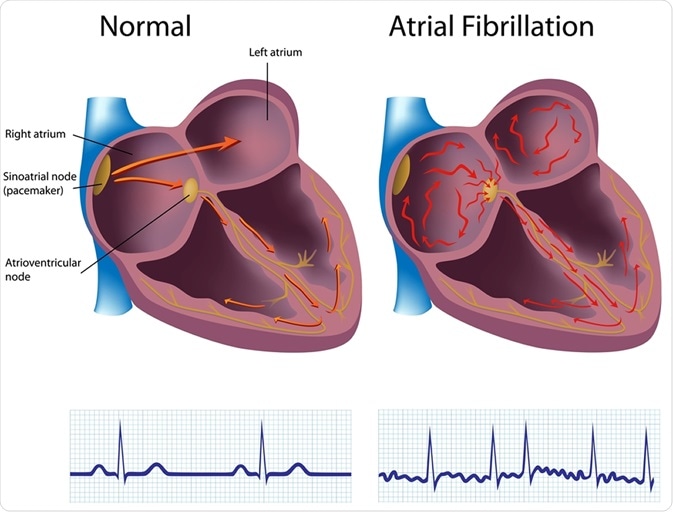Atrial fibrillation, or AF, is the most common arrhythmia. An arrhythmia is a problem with the speed or rhythm of the heartbeat. A disorder in the heart's electrical system causes AF and other types of arrhythmia.
AF occurs when rapid, disorganized electrical signals in the heart's two upper chambers, called the atria, causing them to contract very fast and irregularly (this is called fibrillation). As a result, blood pools in the atria and isn't pumped completely into the heart's two lower chambers, called the ventricles. When this happens, the heart's upper and lower chambers don't work together as they should.
Often, people who have AF may not even feel symptoms. However, even when not noticed, AF can lead to an increased risk of stroke. In many patients, particularly when the rhythm is extremely rapid, AF can cause chest pain, heart attack, or heart failure. AF may occur rarely or every now and then, or it may become a persistent or permanent heart rhythm lasting for years.

Atrial fibrillation. Image Credit: Alila Medical Media / Shutterstock
Understanding the Heart's Electrical System
The heart has an internal electrical system that controls the speed and rhythm of the heartbeat. With each heartbeat, an electrical signal spreads from the top of the heart to the bottom. As it travels, the signal causes the heart to contract and pump blood. The process repeats with each new heartbeat.
Each electrical signal begins in a group of cells called the sinus node, or sinoatrial (SA) node. The SA node is located in the right atrium, which is the heart's upper right chamber. In a healthy adult heart at rest, the SA node fires off an electrical signal to begin a new heartbeat 60 to 100 times a minute. (This rate may be slower in very fit athletes.)
From the SA node, the electrical signal travels through special pathways to the right and left atria. This causes the atria to contract and pump blood into the heart's two lower chambers, the ventricles. The electrical signal then moves down to a group of cells called the atrioventricular (AV) node, located between the atria and the ventricles. Here, the signal slows down just a little, allowing the ventricles time to finish filling with blood.
The electrical signal then leaves the AV node and travels along a pathway called the bundle of His. This pathway divides into a right bundle branch and a left bundle branch. The signal goes down these branches to the ventricles, causing them to contract and pump blood out to the lungs and the rest of the body. The ventricles then relax, and the heartbeat process starts all over again in the SA node.
Understanding the Electrical Problem in Atrial Fibrillation
In AF, the heart's electrical signal begins in a different part of the atria or the nearby pulmonary veins and is conducted abnormally. The signal doesn't travel through normal pathways, but may spread throughout the atria in a rapid, disorganized way. This can cause the atria to beat more than 300 times a minute in a chaotic fashion. The atria's rapid, irregular, and uncoordinated beating is called fibrillation.
The abnormal signal from the SA node floods the AV node with electrical impulses. As a result, the ventricles also begin to beat very fast. However, the AV node can't conduct the signals to the ventricles as fast as they arrive, so even though the ventricles may be beating faster than normal, they aren't beating as fast as the atria. The atria and ventricles no longer beat in a coordinated fashion, creating a fast and irregular heart rhythm. In AF, the ventricles may beat up to 100-175 times a minute, in contrast to the normal rate of 60-100 beats a minute.
When this happens, blood isn't pumped into the ventricles as well as it should be, and the amount of blood pumped out of the ventricles is based on the randomness of the atrial beats. In AF, instead of the body receiving a constant, regular amount of blood from the ventricles, it receives rapid, small amounts and occasional random, larger amounts, depending on how much blood has flowed from the atria to the ventricles with each beat.
Most of the symptoms of AF are related to how fast the heart is beating. If medicines or age slow the heart rate, the effect of the irregular beats is minimized.
AF may be brief, with symptoms that come and go and end on their own, or it may be persistent and require treatment. Or, AF can be permanent, in which case medicines or other interventions can't restore a normal rhythm.
Outlook
People who have AF can live normal, active lives. For some people, treatment can cure AF and return their heartbeat to a normal rhythm. For people who have permanent AF, treatment can successfully control symptoms and prevent complications. Treatment consists primarily of different kinds of medicines or nonsurgical procedures.
Types of Atrial Fibrillation
Paroxysmal Atrial Fibrillation
In paroxysmal atrial fibrillation (AF), the abnormal electrical signals and rapid heart rate begin suddenly and then stop on their own. Symptoms can be mild or severe and last for seconds, minutes, hours, or days.
Persistent Atrial Fibrillation
Persistent AF is a condition in which the abnormal heart rhythm continues until it’s stopped with treatment.
Permanent Atrial Fibrillation
Permanent AF is a condition in which the normal heart rhythm can’t be restored with the usual treatments. Both paroxysmal and persistent atrial fibrillation may become more frequent and eventually result in permanent AF.
What Causes Atrial Fibrillation?
Atrial fibrillation (AF) occurs when the electrical signals traveling through the heart are conducted abnormally and become disorganized and very rapid.
This is the result of damage to the heart’s electrical system. This damage is most often the result of other conditions, such as coronary artery disease or high blood pressure, that affect the health of the heart. Sometimes, the cause of AF is unknown.
Further Reading